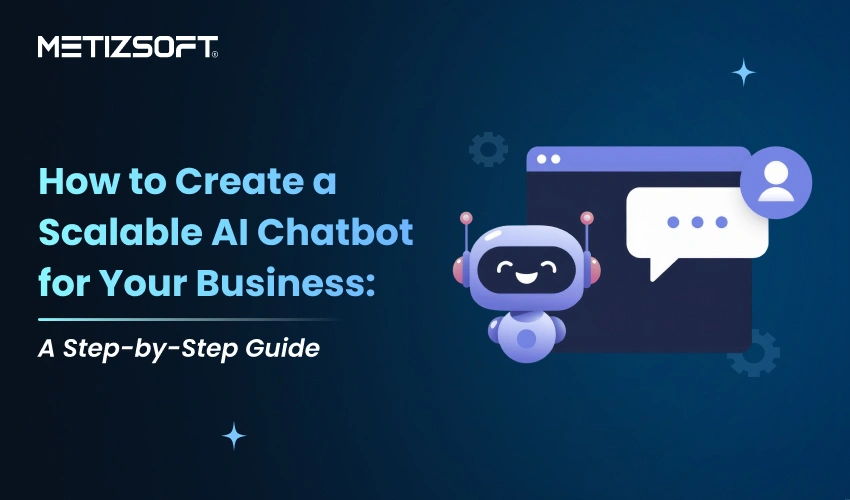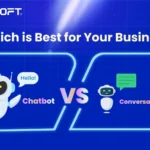
Table of Contents
Summary
A scalable AI chatbot for business is not just a trendy tool; it’s a practical solution to modern customer demands. By combining smart technology, best development practices, and a well-structured foundation, these chatbots help companies handle more customers, save costs, and deliver top-notch 24/7 support. This post unveils how to build, optimize, and future-proof custom AI chatbots for business in clear steps.
Introduction
Today’s customers expect fast, personalized responses, no matter the hour or day. If your business fails to deliver quick help, you risk losing their loyalty and, ultimately, new opportunities. That’s why more companies are adopting scalable AI chatbots for business. These chatbots do more than just answer basic questions. They drive growth, free up support teams, and ensure instant help even during peak times.
This guide explores what makes a chatbot scalable, the benefits for your business, best practices in development, and a clear path to building your own custom AI chatbot. From real-world examples to expert hiring tips, you’ll find everything you need, written simply, in plain language.
Why Scalability Matters in AI Chatbot Development
Scalability means your chatbot can smoothly handle a few or a few million customers without a hitch. In technical terms, it’s about using cloud platforms and modular design so your bot won’t crash when traffic spikes.
For your business, scalability means you’re prepared for busy seasons, expanding to new markets, or sudden promotional booms. The right scalable chatbot solutions keep support costs low, boost efficiency, and maintain customer satisfaction as your company grows.
According to Gartner, chatbots will become the mainstream customer service channel for many organizations by 2027.
Types of Chatbots: Rule-Based vs. AI-Powered vs. Hybrid
Here are the main kinds of chatbots that businesses use:
- Rule-Based Chatbots: These ones follow pre-set rules. They’re really good at answering straightforward, common questions, but they fall flat when things don’t go exactly according to plan. They work well for simple FAQs.
- AI-Powered Chatbots: These are driven by machine learning and natural language processing. They actually learn and get better as they chat with real people. This means they handle more complicated or open-ended questions more effectively.
- Hybrid Chatbots: This is a clever mix. They use rules for the simple stuff and bring in AI for the trickier requests. This approach aims to balance having control over certain interactions while still being flexible enough to handle more complex situations.
Comparison Table: Chatbot Types
For most growing businesses, AI-driven and hybrid solutions offer the best scalability and customer experience.
| Type | Strengths | Weaknessess | Best For |
| Rule-Based | Fast, Simple, Easy to Set Up | Limited flexibility | Basic FAQs, small tasks |
| AI-Powered | Learns, adapts, and handles complex | Needs good data, more costly | Customer support, sales |
| Hybrid | Scalable, reliable, smart fallback | Slightly complex to build | Growing businesses |
For most growing businesses, AI-driven and hybrid solutions offer the best scalability and customer experience.
Core Components of a Scalable AI Chatbot System
Building a truly scalable AI chatbot means combining several key systems that work together:
- Natural Language Processing (NLP) Engine: The chatbot’s brain helps it understand customer questions in plain English (or other languages). Advanced NLP means fewer misunderstood queries and happier users.
- Dialogue Management System: Keeps conversations smooth and logical, no matter how many twists and turns. This is what helps the chatbot handle follow-up questions like a real human.
- Backend Services / Business Logic: Where the magic happens, connecting your chatbot to databases, CRMs, order systems, and workflow automations.
- Integration Layer (APIs, Microservices): Enables the bot to talk with your website, app, WhatsApp, or any other platform. APIs enable your chatbot to book orders, answer “Where is my package?” questions, and more, all in real-time.
- Machine Learning for Continuous Improvement: The best chatbots get smarter over time, using customer feedback and new data to fine-tune answers and spot new trends.
- Deployment & Scaling Infrastructure: Using scalable cloud servers, containers (like Docker), and databases lets your chatbot grow with demand. No downtime, no lost sales during busy periods.
Putting all these pieces together creates a chatbot that’s not just smart, but ready for anything your business (or customers) throws at it.
Comparison Table: Top Scalable Chatbot Platforms & Tools
| Platform/Tool | NLP Strength | Scalability | Integration | Ease of Use | Limitation |
| Google Dialogflow | Advanced | High | APIs, GCP, 3rd-party | Moderate | Needs Google Cloud |
| Microsoft Azure | Excellent | Very High | Microsoft stack | Moderate | Less customizable |
| Rasa Open Source | Customizable | Enterprise | On-prem/Cloud | Dev-friendly | Requires coding |
| Botsify | Good | Medium | Social, web, apps | No-code, easy | Less suited for complex |
| Landbot | Moderate | Good | Website, WhatsApp | Visual builder | Not ideal for a huge scale |
Tools like Rasa are often top picks for completely custom, enterprise-grade solutions where you need tight control and security.
How to Build an AI Chatbot That Scales: Step-by-Step Guide
- Define Business Needs & Use Cases: Start by asking, ‘What problem will my chatbot solve?’ Customer support, order tracking, sales assistance? Clear goals make your project focused.
- Design Conversation Flows: Map out real questions your customers ask. Draft simple, natural replies first, then add branching paths for follow-ups. Tools like flowcharts make this easy.
- Select Technology Stack / Platform: Choose a platform that matches your needs for scalability, security, and budget, like Dialogflow, Rasa, or Azure.
- Gather & Train Data for NLP: Use transcripts, support logs, and sample queries to help the chatbot learn natural language. The more varied your data, the smarter your bot will be.
- Build & Integrate Core Components: Develop the chatbot modules, NLP, dialogue manager, integrations with CRMs, databases, and other systems.
- Testing (Including Load Testing): Test conversations for accuracy and user experience. Simulate heavy traffic (load testing) to reveal weaknesses before launch.
- Deploy on Scalable Infrastructure: Use cloud platforms and containers so your bot can auto-scale to handle busy times. This prevents slowdowns or outages.
- Monitor & Iterate (Ongoing Improvement): Track performance, review metrics, and use actual user feedback to update conversation flows and add new features.
Best Practices for Scalable AI Chatbot Development
- Define the chatbot’s main goals and tasks early.
- Use a modular, flexible design so it’s easy to tweak features as you grow.
- Integrate with your key business tools (CRM, website, analytics).
- Monitor metrics, such as response time and resolution rate.
- Have seamless human handoff for tough queries.
- Enable caching and async processing for extra speed.
- Plan for security: encryption, data privacy, compliance from day one.
- Set up feedback loops to improve accuracy over time.
Real-World Examples & Business Outcomes
- E-commerce: Tidio enables online stores to answer product and shipping queries instantly, leading to a 40% rise in conversions and fewer abandoned carts.
- Telecoms: T-Mobile’s advanced AI agent allows customers to self-serve, handle billing, and update profiles anytime, cutting down wait times and boosting satisfaction.
- Retail/Support: Photobucket saw customer satisfaction rise by 3% and improved first-resolution times after deploying a scalable AI chatbot.
McKinsey’s 2025 survey highlights that more than 71% of companies are now using AI chatbots for at least one of their functions, with IT, marketing, customer support, and product development being the most popular areas.
Why Hire an AI Development Company?
When customization, data security, or rapid scaling matter, hiring an experienced AI development company can save both time and money.
Dedicated developers provide:
- Tailored, brand-aligned chatbots that meet unique business needs.
- Smooth integrations with your current systems, ensuring workflows remain unified.
- Quick, reliable delivery and proactive support, even post-launch.
- Advanced skills in NLP, machine learning, and security best practices.
- Scalable solutions that adapt and align perfectly as your business grows, with no surprise breakdowns as demand grows
Future Trends: What’s Next in AI Chatbots?
The next era for AI chatbots is packed with exciting advances:
- Emotion detection: Bots will sense tone and mood for more empathetic help.
- Proactive engagement: Chatbots will reach out with solutions before users even ask.
- Tighter business integration: Bots will shape personalized offers, power advanced analytics, and handle complex transactions, all in real time.
- Voice and video assistants: Moving beyond text for even more natural customer engagement.
Anticipate that even more companies will be turning to AI chatbots to achieve success by 2026.
Final Takeaways
Creating a scalable AI chatbot for your business is a savvy move to stay competitive. By concentrating on best practices and establishing a strong groundwork, you’ll enhance customer happiness, cut down on expenses, and drive new growth.
If you’re ready, start by reviewing your business needs, exploring top platforms, and consulting with experts from a trusted AI development company. Don’t get left behind, embrace AI chatbots and level up your business for tomorrow’s customers.
Ready to future-proof your customer support? Start building your scalable AI chatbot for business today!
Frequently Asked Questions (FAQs)
Will my AI chatbot require constant updates?
Yes. The best AI chatbots use feedback and analytics to refine answers and add new features. Regular updates ensure your chatbot remains relevant and effective as your business and customer needs change.
How long does AI chatbot development take?
Typical projects take 4–16 weeks, factoring in planning, data gathering, development, testing, and deployment.
What are the main challenges with scalable chatbots?
Common hurdles: Integration with existing systems, language understanding, handling peak loads, and continuous learning for improvement.
How do I ensure my AI chatbot handles sensitive information securely?
Choose a chatbot development service or AI development company experienced in encryption, compliance (like GDPR), and secure data handling. Always ask about their security track record.
AboutManthan Bhavsar
Related Posts
Top 5 Frameworks to Building Progressive Web Apps in 2023
Ever since the smartphones came into existence and the websites’ popularity increased, merging the two to create an...
How To Disable TLS 1.0 With IIS?
SSL and TLS are cryptographic protocols that provide authentication and data encryption between different endpoints (e.g., a...

